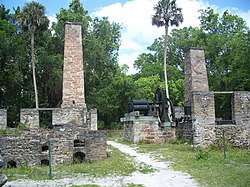Dunlawton Plantation and Sugar Mill
|
Dunlawton Plantation-Sugar Mill Ruins
|
|
 |
|
| Location | Port Orange, Florida |
|---|---|
| Coordinates | 29°8′27″N 81°0′22″W / 29.14083°N 81.00611°WCoordinates: 29°8′27″N 81°0′22″W / 29.14083°N 81.00611°W |
| NRHP Reference # | 73000606 |
| Added to NRHP | August 28, 1973 |
The Dunlawton Plantation and Sugar Mill was a plantation in north-central Florida that was destroyed by the Seminoles at the beginning of the Second Seminole War. The ruins are located at 950 Old Sugar Mill Road, Port Orange, Florida. On August 28, 1973, the site was added to the United States National Register of Historic Places under the title of Dunlawton Plantation-Sugar Mill Ruins.
The ruins are now part of the Dunlawton Sugar Mill Gardens. The botanical gardens include interpretive signs about the enclosed ruins, large concrete sculptures of dinosaurs and a giant ground sloth, a gazebo, and plantings of grasses, flowers, bushes and native plants under a canopy of oak trees.
The Dunlawton Plantation and its sugar mill date to the latter years of the Second Spanish period in Florida. In August 1804, Patrick Dean, a merchant from the Bahamas, and his uncle John Bunch, a planter from Nassau, were granted by the Spanish Crown land in Florida that had been part of the British Turnbull grant of 1777. Dean established a 995-acre indigo and sugarcane plantation in what is now the Port Orange area, using the labor of enslaved Africans to cultivate and process the crops. Dean apparently was killed by a renegade Indian or slave during the First Seminole War in 1818, and left the plantation to his aunt Cecily, the wife of his uncle John Bunch, who had set up his own plantation on the grant to the north of Dean's property. Cecily died soon after Dean, and the plantation passed to John Bunch, who operated the two properties until 1830 as a single plantation.
John B. Bunch McHardy, an officer in the British Navy and grandson of John and Cecily Bunch, eventually inherited the former Dean property. He had no interest in running a plantation, and sold the land to land dealers Charles and Joseph Lawton for $3,000 dollars. In 1832, the brokers sold it to Sarah Anderson and her two sons, George and James, for $4,500. The name Dunlawton was formed by combining her maiden name, Dunn, with the land dealers' name, Lawton. The brothers operated the mill with slave labor—processing sugar, molasses and rum on the property until December 1835, when the Second Seminole Indian War began.
...
Wikipedia

